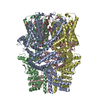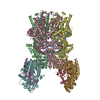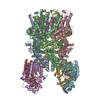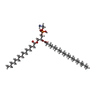[English] 日本語
 Yorodumi
Yorodumi- PDB-8gvw: Cryo-EM structure of the human TRPC5 ion channel in lipid nanodis... -
+ Open data
Open data
- Basic information
Basic information
| Entry | Database: PDB / ID: 8gvw | |||||||||||||||||||||||||||||||||
|---|---|---|---|---|---|---|---|---|---|---|---|---|---|---|---|---|---|---|---|---|---|---|---|---|---|---|---|---|---|---|---|---|---|---|
| Title | Cryo-EM structure of the human TRPC5 ion channel in lipid nanodiscs, class2 | |||||||||||||||||||||||||||||||||
 Components Components | Short transient receptor potential channel 5 | |||||||||||||||||||||||||||||||||
 Keywords Keywords | METAL TRANSPORT / transient receptor potential | |||||||||||||||||||||||||||||||||
| Function / homology |  Function and homology information Function and homology informationregulation of membrane hyperpolarization / phosphatidylserine exposure on apoptotic cell surface / negative regulation of dendrite morphogenesis / Role of second messengers in netrin-1 signaling / store-operated calcium channel activity / inositol 1,4,5 trisphosphate binding / cation channel complex / actinin binding / clathrin binding / TRP channels ...regulation of membrane hyperpolarization / phosphatidylserine exposure on apoptotic cell surface / negative regulation of dendrite morphogenesis / Role of second messengers in netrin-1 signaling / store-operated calcium channel activity / inositol 1,4,5 trisphosphate binding / cation channel complex / actinin binding / clathrin binding / TRP channels / regulation of cytosolic calcium ion concentration / positive regulation of axon extension / positive regulation of neuron differentiation / calcium channel complex / calcium ion transmembrane transport / calcium channel activity / neuron differentiation / calcium ion transport / nervous system development / presynapse / positive regulation of cytosolic calcium ion concentration / growth cone / ATPase binding / actin binding / neuron apoptotic process / neuronal cell body / positive regulation of cell population proliferation / dendrite / plasma membrane Similarity search - Function | |||||||||||||||||||||||||||||||||
| Biological species |  Homo sapiens (human) Homo sapiens (human) | |||||||||||||||||||||||||||||||||
| Method | ELECTRON MICROSCOPY / single particle reconstruction / cryo EM / Resolution: 3.59 Å | |||||||||||||||||||||||||||||||||
 Authors Authors | Won, J. / Jeong, H. / Lee, H.H. | |||||||||||||||||||||||||||||||||
| Funding support |  Korea, Republic Of, 1items Korea, Republic Of, 1items
| |||||||||||||||||||||||||||||||||
 Citation Citation |  Journal: Nat Commun / Year: 2023 Journal: Nat Commun / Year: 2023Title: Molecular architecture of the Gα-bound TRPC5 ion channel. Authors: Jongdae Won / Jinsung Kim / Hyeongseop Jeong / Jinhyeong Kim / Shasha Feng / Byeongseok Jeong / Misun Kwak / Juyeon Ko / Wonpil Im / Insuk So / Hyung Ho Lee /   Abstract: G-protein coupled receptors (GPCRs) and ion channels serve as key molecular switches through which extracellular stimuli are transformed into intracellular effects, and it has long been postulated ...G-protein coupled receptors (GPCRs) and ion channels serve as key molecular switches through which extracellular stimuli are transformed into intracellular effects, and it has long been postulated that ion channels are direct effector molecules of the alpha subunit of G-proteins (Gα). However, no complete structural evidence supporting the direct interaction between Gα and ion channels is available. Here, we present the cryo-electron microscopy structures of the human transient receptor potential canonical 5 (TRPC5)-Gα complexes with a 4:4 stoichiometry in lipid nanodiscs. Remarkably, Gα binds to the ankyrin repeat edge of TRPC5 ~ 50 Å away from the cell membrane. Electrophysiological analysis shows that Gα increases the sensitivity of TRPC5 to phosphatidylinositol 4,5-bisphosphate (PIP), thereby rendering TRPC5 more easily opened in the cell membrane, where the concentration of PIP is physiologically regulated. Our results demonstrate that ion channels are one of the direct effector molecules of Gα proteins triggered by GPCR activation-providing a structural framework for unraveling the crosstalk between two major classes of transmembrane proteins: GPCRs and ion channels. | |||||||||||||||||||||||||||||||||
| History |
|
- Structure visualization
Structure visualization
| Structure viewer | Molecule:  Molmil Molmil Jmol/JSmol Jmol/JSmol |
|---|
- Downloads & links
Downloads & links
- Download
Download
| PDBx/mmCIF format |  8gvw.cif.gz 8gvw.cif.gz | 491.7 KB | Display |  PDBx/mmCIF format PDBx/mmCIF format |
|---|---|---|---|---|
| PDB format |  pdb8gvw.ent.gz pdb8gvw.ent.gz | 406.7 KB | Display |  PDB format PDB format |
| PDBx/mmJSON format |  8gvw.json.gz 8gvw.json.gz | Tree view |  PDBx/mmJSON format PDBx/mmJSON format | |
| Others |  Other downloads Other downloads |
-Validation report
| Summary document |  8gvw_validation.pdf.gz 8gvw_validation.pdf.gz | 1.7 MB | Display |  wwPDB validaton report wwPDB validaton report |
|---|---|---|---|---|
| Full document |  8gvw_full_validation.pdf.gz 8gvw_full_validation.pdf.gz | 1.7 MB | Display | |
| Data in XML |  8gvw_validation.xml.gz 8gvw_validation.xml.gz | 80 KB | Display | |
| Data in CIF |  8gvw_validation.cif.gz 8gvw_validation.cif.gz | 119.2 KB | Display | |
| Arichive directory |  https://data.pdbj.org/pub/pdb/validation_reports/gv/8gvw https://data.pdbj.org/pub/pdb/validation_reports/gv/8gvw ftp://data.pdbj.org/pub/pdb/validation_reports/gv/8gvw ftp://data.pdbj.org/pub/pdb/validation_reports/gv/8gvw | HTTPS FTP |
-Related structure data
| Related structure data |  34300MC  7x6cC  7x6iC  8gvxC M: map data used to model this data C: citing same article ( |
|---|---|
| Similar structure data | Similarity search - Function & homology  F&H Search F&H Search |
- Links
Links
- Assembly
Assembly
| Deposited unit | 
|
|---|---|
| 1 |
|
- Components
Components
-Protein , 1 types, 4 molecules ABCD
| #1: Protein | Mass: 89951.891 Da / Num. of mol.: 4 Source method: isolated from a genetically manipulated source Details: reisdues 766,777(SR) restriction enzyme site, XbaI, residues 768-773(LEVLFQ) protease cleavage site, HRV-3C Source: (gene. exp.)  Homo sapiens (human) / Gene: TRPC5, TRP5 / Cell line (production host): HEK293 / Production host: Homo sapiens (human) / Gene: TRPC5, TRP5 / Cell line (production host): HEK293 / Production host:  Homo sapiens (human) / References: UniProt: Q9UL62 Homo sapiens (human) / References: UniProt: Q9UL62 |
|---|
-Non-polymers , 6 types, 24 molecules 










| #2: Chemical | ChemComp-PTY / #3: Chemical | ChemComp-POV / ( #4: Chemical | ChemComp-Y01 / #5: Chemical | ChemComp-ZN / #6: Chemical | ChemComp-CA / #7: Chemical | ChemComp-YZY / ( |
|---|
-Details
| Has ligand of interest | Y |
|---|---|
| Has protein modification | Y |
-Experimental details
-Experiment
| Experiment | Method: ELECTRON MICROSCOPY |
|---|---|
| EM experiment | Aggregation state: PARTICLE / 3D reconstruction method: single particle reconstruction |
- Sample preparation
Sample preparation
| Component | Name: Transient receptor potential / Type: COMPLEX / Entity ID: #1 / Source: RECOMBINANT |
|---|---|
| Molecular weight | Experimental value: NO |
| Source (natural) | Organism:  Homo sapiens (human) Homo sapiens (human) |
| Source (recombinant) | Organism:  Homo sapiens (human) / Cell: HEK293 Homo sapiens (human) / Cell: HEK293 |
| Buffer solution | pH: 8 |
| Specimen | Embedding applied: NO / Shadowing applied: NO / Staining applied: NO / Vitrification applied: YES |
| Vitrification | Cryogen name: ETHANE |
- Electron microscopy imaging
Electron microscopy imaging
| Microscopy | Model: TFS GLACIOS |
|---|---|
| Electron gun | Electron source:  FIELD EMISSION GUN / Accelerating voltage: 200 kV / Illumination mode: FLOOD BEAM FIELD EMISSION GUN / Accelerating voltage: 200 kV / Illumination mode: FLOOD BEAM |
| Electron lens | Mode: BRIGHT FIELD / Nominal defocus max: 2000 nm / Nominal defocus min: 1000 nm |
| Image recording | Electron dose: 40 e/Å2 / Film or detector model: FEI FALCON IV (4k x 4k) |
- Processing
Processing
| Software | Name: PHENIX / Version: 1.19.2_4158: / Classification: refinement | ||||||||||||||||||||||||
|---|---|---|---|---|---|---|---|---|---|---|---|---|---|---|---|---|---|---|---|---|---|---|---|---|---|
| EM software | Name: PHENIX / Category: model refinement | ||||||||||||||||||||||||
| CTF correction | Type: PHASE FLIPPING AND AMPLITUDE CORRECTION | ||||||||||||||||||||||||
| 3D reconstruction | Resolution: 3.59 Å / Resolution method: FSC 0.143 CUT-OFF / Num. of particles: 33153 / Symmetry type: POINT | ||||||||||||||||||||||||
| Refine LS restraints |
|
 Movie
Movie Controller
Controller





 PDBj
PDBj







